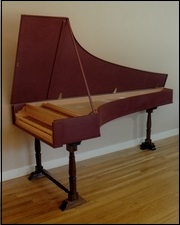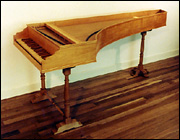
Lemont, PA 16851
(814) 883-7799
damaple@comcast.net

Please click on images below for enlarged versions.
Harpsichord after Girolamo Zenti, ca. 1666
 |
 |
Specification:
GG-d3, 8' 8'. Inner case of cypress or maple. 236 x 89 cm (93 x 35 in).
Additional images:
Keyboard detail, false inner case style
The false-inner-case instrument pictured above can be seen and heard in performances by Sandra Mangsen of two pieces by Thomas Tomkins, available on YouTube.com.
![]()
Harpsichord after Giacomo Ridolfi, 1665
I also offer a short-octave model based on an example by Ridolfi, which is easily tranported and ideal for continuo use. Ridolfi claimed to be a student of Zenti, so it is not suprising that the two instruments are similar in some respects. The Ridolfi has a similar robust quality, but the smaller case affects the bass resonance, yielding a tighter, more direct sound. Its molding scheme is also simpler compared to the Zenti, and there is no rose, allowing a lower price. The keyboard of the instrument in the photo was designed with crossing levers in the bass, which allows the keyboard to be moved for pitch transposition without the usual re-tuning problems caused by the short octave design. Available with the traditional separate inner and outer cases, or in the false-inner-case style.

![]()
Specification:
C/E-c3, 8' 8' (45 notes). Case of cypress or maple. 195 x 82 cm (77 x 32 in).
![]()